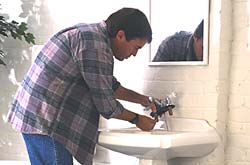Royal Flush: Bathroom and Toilet Plumbing
See if We Have Top-Rated
Plumbing Contractors in Your Area

In keeping with the old adage, "don't know what you've got till it's gone", bathroom and toilet plumbing is rarely noticed until something goes awry. Understanding how the devices specific to your bathroom work can help with immediate trouble shooting, and may save you a plumber's bill or two.
How Toilet Plumbing Works
There are only a few standard parts that need to be understood to make a toilet operate normally. Basically, toilet plumbing is a four step process. The flush handle on the outside of a toilet is connected to a chain inside the tank. This chain is connected to a "flapper" on the tank's bottom. The first step begins when the handle is pushed down and the chain pulls the flapper up. This releases the water from the tank and sends it to the toilet bowl. With me so far?
Okay, the next step occurs when the toilet's tank empties its water into the toilet bowl. This water performs a dual function. First, it pushes the dirty water and waste out of the bowl and into a pipe leading to the sewer or septic tank. Second, it refills the bowl with clean water. After this, the flapper again seals the passage of water from tank to bowl and the tank begins filling back up in preparation for the next flush.
The last two steps are carried out differently depending on the age of the toilet plumbing. The third step is refilling the tank, the fourth is stopping that refilling at the right moment. After a flush, the tank is empty and new water begins flowing in. In a conventional toilet, there is a float that sets this process in motion. The emptied tank causes the float to sink and rest at the bottom. The change in position of the float opens a valve (called a ball-cock), which allows clean water to run into the tank. As the tank fills, the float rises to its original position. When it hits that position, the ball-cock closes. The water stops flowing into the tank, and the toilet is ready for the next flush.
Newer toilets don't have a float. The ball-cock itself is sensitive to water pressure. It opens to send new water into the tank after a flush (when the tank is empty and there is no water pressure). It closes when the water level hits a specified point (when the tank is full and water pressure is high).
Don't stop with just the pipes! Use this link for a complete
Bathroom Remodel
Shower Plumbing
The difficulty with shower plumbing is that much of it is often hidden in walls for only the professional or experienced DIY to find. There are a few things, though, that can be done by anyone to help your shower work up to its potential.
Shower plumbing is notorious for hair clogs. A chemical drain cleaner can be used once a month to stop clogs before they set in. The strainer that covers your shower's drain should be removed and cleaned regularly (if there is no strainer on your drain, purchasing one is cheap and could save a lot of trouble in the long run).
If you already have a clog, try plunging your shower drain. If this is ineffective, a "snake", or auger might do the trick. Chemical drain cleaner can be used here, too. It is important, however, to recognize how caustic the stuff is. Never try plunging a drain of any kind after filling it with drain cleaner.
Low flow from your shower head is sometimes caused by a blockage in the head itself. Shower heads are inexpensive and easy to replace. Check, though, when you first remove it to see if there is any debris inside of it. Sometimes debris from old pipes can get lodged in the head and create low shower pressure.
More Tips & Advice For Your Home
- Recent Articles

